Desertification is a process, natural or not, of land degradation which originates from climate change and/or the consequences of human activities. This results in local aridification and drought following land degradation, which leads to a desert-like territory. It constitutes a long-term natural disaster. Indeed, in almost all regions of the world, desertification is the main danger to crops and livestock. Today, almost half of the world’s population is affected by land degradation, particularly the poorest populations. Furthermore, this phenomenon threatens approximately half of global GDP. If nothing changes by 2050, additional degradation of 16 million km² of land can be expected.
The causes of desertification are numerous and almost all attributable to humans. They cause numerous environmental, but also socio-economic, consequences. However, the United Nations (UN) proposes several scenarios to combat this phenomenon.
Causes of desertification
Soils are deteriorating on all continents under the effect of climate change, increasingly frequent droughts, but above all the pressure of human activities. Thus, the causes of desertification are numerous and almost all attributable to Man and unsuitable agricultural practices:
- Deforestation;
- Overexploitation of land and overgrazing by livestock (excessive exploitation of plant resources on an area);
- The absence of fallow in the crop cycle, leading to agricultural desertification;
- The depletion of groundwater;
- Mining;
- Climate variations;
- Human activities (agriculture, bush fires, etc.);
- Policies leading to unsustainable use of resources and a lack of adequate infrastructure;
- Geomorphological factors, linked to orogeny and lithology, determine resistance to erosion and desertization;
- Global warming;
- Accelerated urbanization.
Succinctly, the natural causes of desertification are all extreme climatic phenomena linked to climate change. Accentuated by global warming, a consequence of greenhouse gas emissions linked to activity human, Men are indirectly responsible for these phenomena.
Consequences of desertification
Desertification has many environmental, but also socio-economic, consequences.
At the environmental level:
- Soil impoverishment;
- Degradation of ecosystems and biodiversity;
- Reduction in carbon storage capacity in soils and increased global warming;
- Resource scarcity and water shortages;
- Etc.
Socio-economically:
- Increase in poverty;
- Food insecurity;
- Deterioration of living conditions;
- Inequalities in access to natural resources;
- Migration of populations;
- Increase in conflicts and insecurity;
- Etc.
As a result of desertification, land becomes unusable and diseases and famine appear. Populations move and generally cause conflicts. According to the United Nations, 50 million people could be displaced in the next ten (10) years due to desertification.
Solutions
UNCCD COP 15 adopted thirty-six (36) decisions to improve drought resilience, reduce land degradation and invest in land restoration efforts, including an agreement for:
- Accelerate the restoration of one billion hectares of degraded land by 2030 through improved data collection, monitoring and reporting;
- Strengthen resilience to drought by adopting a new and improved partnership model for large-scale integrated investment programs across the landscape;
- Improve national policies and early warning, monitoring and evaluation, particularly regarding sand and dust storms and drought;
- Improve efforts around capacity building, sharing of knowledge and lessons learned, and coordination of these efforts at the regional level;
- Establish an intergovernmental drought working group for 2022-2024 to support the shift from reactive to proactive drought management;
- Improve women’s participation in land management by ensuring secure land tenure and collecting gender-disaggregated data on the impacts of desertification, land degradation and drought ;
- Develop policies to reduce the impact and occurrence of sand and dust storms through early warning, risk assessment and reduction of human-caused causes;
- Ensure greater synergies between the three (03) Rio Conventions, including complementarities in the implementation of these treaties through nature-based solutions and the definition of objectives at the national level;
- Strengthen the participation of civil society organizations and young people in the work and meetings of the UNCCD.
In addition, the UN proposes, among other recommendations, to eradicate desertification:
- Soil conservation with the massive creation of protected areas;
- The Great Green Wall, a program launched in 2007 which aims to restore, by 2030, 100 million hectares of degraded land in the eleven (11) countries of the Sudano-Sahelian zone.
Ultimately, combating desertification is a very difficult task. Indeed, each case of desertification presents unique characteristics and must be treated in a specific way. There is therefore no panacea, but depending on the case, different techniques to deal with desertification.
